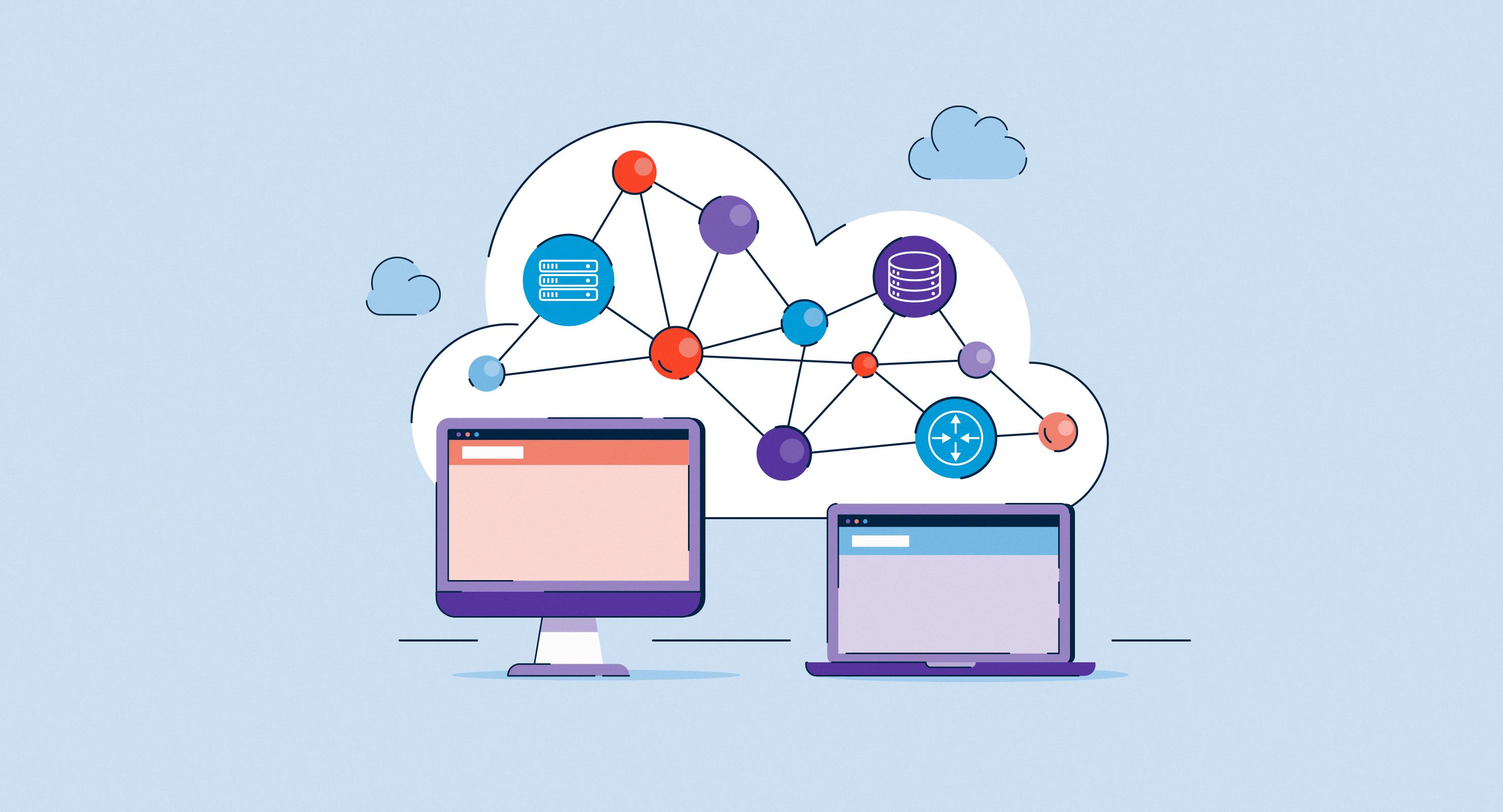Network Functions Virtualization (NFV) is a revolutionary technology that is transforming the way networks are designed and operated. In simple terms, it enables the use of virtual machines and software to replace physical networking appliances, allowing for more efficient and cost-effective networking solutions. NFV is becoming increasingly popular as organizations look to reduce their operational costs, while still maintaining high-performance levels.
At its core, NFV allows for network functions such as firewalls and load balancers to be virtualized. This means that instead of having to purchase, install and maintain dedicated physical hardware, these functions can now be implemented in software running on virtual machines. This significantly reduces the costs associated with deploying these types of functions – not only in terms of capital expenditure but also in terms of operational expenditure. The cost savings can be used to increase the performance of existing services or to deploy new services which would have been too expensive with traditional hardware solutions.
The components which make up an NFV architecture include the Virtualized Network Functions (VNFs), the NFV Infrastructure (NFVI), and the NFV Management and Orchestration (MANO). VNFs are essentially virtualized versions of existing network functions such as firewalls or routers, running on top of a hypervisor. The NFVI provides the underlying compute resources needed for running VNFs – typically this will involve servers with adequate processing power to run multiple VNFs at once. Finally, MANO provides a layer of abstraction that allows for easy management and orchestration of VNFs across multiple nodes within an environment.
One key benefit to using NFV is that it makes it easier for organizations to quickly deploy new services or increase capacity within existing services without a lot of manual intervention or configuration changes on individual nodes. By leveraging automated orchestration tools such as OpenStack or Kubernetes, IT teams can quickly provision new VNFs across multiple nodes in an environment without needing any specialized knowledge about each node’s configuration. This makes it much easier for IT teams to scale up applications quickly when demand increases – something which was not possible with traditional hardware solutions due to their complexity.
Ultimately, Network Functions Virtualization provides organizations with an unprecedented level of flexibility when it comes to designing and deploying network architectures – allowing them to scale up quickly while reducing costs associated with managing physical hardware appliances. It’s no surprise then that NFV is becoming increasingly popular among organizations looking for more efficient ways to manage their networks quickly and cost-effectively.
Network Function Virtualization
Network Functions Virtualization (NFV) is an approach to networking in which some or all of the network functions traditionally run on dedicated hardware devices are virtualized and run on commodity computing hardware. For example, instead of using dedicated routers or firewalls, NFV enables these services to be provided by software running on a general-purpose server. This approach reduces costs by eliminating the need for specialized hardware and allows for more flexibility in the deployment of networking services. Additionally, NFV can provide increased scalability and performance compared to conventional networking appliances.

Source: g2.com
Example of Network Function Virtualization (NFV)
Network Function Virtualization (NFV) is a technology that allows network functions and services to be virtualized and delivered as software over standardized high-volume servers, switches, and storage. NFV provides an agile and cost-effective way to deploy and manage a wide range of network services.
Examples of NFV include virtualized load balancers, session border controllers, firewalls, WAN accelerators, intrusion detection devices, DNS servers, web application firewalls, content delivery networks (CDN), mobile packet core functions such as SAE Gateways or SGW’s (Serving Gateway), evolved packet core functions such as MME’s (Mobility Management Entities), Policy Charging Rules Functions (PCRF), LTE Radio Access Network elements such as eNodeBs or gNodeBs (Evolved Node B/GSM Node B), VoIP gateways, IP Multimedia Subsystems (IMS) components such as MGCF/MRFC/MRFP/IBCF/HSS, etc., video transcoding nodes and other network elements.
The Benefits of Software-Defined Networking (SDN) and Network Function Virtualization (NFV)
Software-defined networking (SDN) is a new approach to computer networking that allows network administrators to manage network services through the abstraction of lower-level functionality. It is achieved by decoupling the system that makes decisions about where traffic is sent (the control plane) from the underlying systems that forward traffic to the selected destination (the data plane). This separation enables network control to become directly programmable and the underlying infrastructure to be abstracted for applications and network services.
Network functions virtualization (NFV) is a technology based on virtualizing the entire set of network functions used in communication networks. It enables telecom operators to build networks using software-based components instead of proprietary hardware-based ones. This allows them to move away from traditional, hardware-based networks and towards cloud-based, software-defined networks that are more flexible, scalable, and cost-effective. NFV also helps telecom operators quickly deploy new services with the minimal upfront investment in hardware or software.
The Three Main Components of NFV Architecture
The three main components of a Network Function Virtualization (NFV) architecture are the Virtualized Network Functions (VNFs), NFV Infrastructure (NFVI), and NFV Management and Orchestration (MANO).
VNFs are applications that perform specific network functions, such as firewalls, routers, or load balancers. They are designed to run on virtualized infrastructure and can be combined in various ways to create new services. VNFs can be deployed in an automated way, making them easy to manage and scale.
The NFVI is the underlying virtualized infrastructure that supports the VNFs. It includes physical servers, storage systems, network switches/routers, and other network components. The NFVI provides necessary computing resources for the VNFs to run efficiently.
Finally, MANO is responsible for managing the lifecycle of VNFs from initial deployment to updates and upgrades. It is also responsible for orchestrating interactions between different VNFs as well as providing monitoring capabilities for performance optimization. MANO helps ensure that all components of an NFV architecture are correctly configured and running optimally at all times.
The Benefits of Network Function Virtualization (NFV)
NFV (Network Function Virtualization) is a technology that enables network functions such as firewalls, load balancers, and routers to be virtualized and deployed as software-based services instead of physical hardware devices. This technology has many benefits for businesses and organizations, including cost savings, scalability, flexibility, reduced complexity, and improved security.
Cost Savings: By virtualizing network functions and deploying them as software-based services, organizations can reduce operational expenses associated with physical hardware device purchases and maintenance. Furthermore, NFV can help increase the utilization of existing infrastructure resources by allowing multiple services to be deployed on the same server or cloud environment.
Scalability: NFV allows organizations to quickly scale up or down their networks based on changing needs without having to purchase additional physical hardware devices. This flexibility allows organizations to take advantage of sudden spikes in demand or quickly move resources from one location to another depending on need.
Flexibility: By decoupling network functions from dedicated hardware devices, NFV provides an unprecedented level of flexibility when it comes to deploying new services or reconfiguring existing ones. It also allows businesses to deploy their services in any number of locations across the globe without having to worry about capacity constraints or limited server space.
Reduced Complexity: By virtualizing network functions into software-based services, organizations are able to eliminate the complexity associated with managing multiple physical hardware devices in disparate locations. This reduces the need for specialized staff members who understand how these hardware systems work together and makes it easier for them to deploy new services or reconfigure existing ones using standardized software toolsets.
Improved Security: NFV also helps improve the security of networks by eliminating single points of failure that can arise due to the proliferation of dedicated hardware devices in disparate locations. By deploying virtualized network functions across multiple servers or cloud environments, organizations are able to ensure that if one system fails there will always be another available backup system ready to take over its duties without disruption.
Understanding NFV in 5G
Network Function Virtualization (NFV) is a key component of 5G technology. It is a network architecture model that allows for the virtualization of network functions and services that would traditionally be provided by physical infrastructure such as routers and switches. This makes it easier to manage, scale, and move network functions across distributed hardware resources. NFV allows operators to better control their networks by enabling them to add new features or expand capacity without having to purchase additional hardware. This also improves overall performance and reduces operational costs by utilizing existing resources more efficiently. Additionally, NFV promotes increased flexibility in the way 5G networks are designed and deployed, allowing operators to quickly respond to changing demands.
What is Network Function Virtualization (NFV) on My Phone?
Network Function Virtualization (NFV) is a technology that allows for the virtualization of network functions, such as firewalls, routers, and load balancers. By virtualizing these functions, NFV makes it easier to deploy and manage them on mobile devices. This offers users greater flexibility and scalability, allowing them to quickly adapt their networks to changing conditions or new requirements. Additionally, NFV can help reduce costs associated with deploying physical hardware by consolidating multiple functions into a single virtualized device. On mobile devices, NFV enables users to customize their networks as needed without needing to purchase additional hardware.
Who Benefits from NFV?
NFV is primarily used by telecom companies around the world, as they are the main beneficiaries of the technology. NFV allows them to reduce their reliance on expensive physical network hardware and instead create a virtual network that can be managed more efficiently. In addition, NFV offers a much greater degree of flexibility, allowing companies to quickly and easily change or add services without having to make major changes to their physical network infrastructure. Other industries that have started using NFV include financial services, government agencies, healthcare organizations, and educational institutions.
The Key Difference Between SDN and NFV
The key difference between SDN and NFV is that SDN is a network management technology that provides an abstraction layer between the physical network infrastructure and the applications, while NFV is a networking architecture that enables virtualized networking functions to be run on commodity hardware. In other words, SDN provides a centralized approach to configuring, managing, and monitoring networks, while NFV is a way of running networking functions virtually in order to reduce costs and increase flexibility.
SDN allows for more dynamic control of the network by allowing for automated processes such as provisioning, configuration, and monitoring. It also makes it easier to manage networks across multiple sites and providers. On the other hand, NFV enables physical network elements to be replaced with virtual ones which can be hosted anywhere. This has several advantages such as lower costs, faster deployment times, and improved scalability. Additionally, NFV also simplifies operations by allowing applications to be decoupled from their underlying infrastructure.
The Use of SDN and NFV in 5G Networks
Yes, Software Defined Networking (SDN) and Network Functions Virtualization (NFV) are important components of 5G technology. SDN and NFV are used to give operators greater control over their networks and to enable them to create virtualized networks that can be segmented or “sliced” according to customer needs. This allows operators to manage resources more efficiently and with greater flexibility than traditional physical networks. With SDN and NFV, operators can provide customers with greater control over their network traffic, improved performance, and increased scalability. Additionally, the use of these technologies makes it possible for operators to deploy 5G services, reducing time-to-market for new services.
Understanding the Layers of NFV
The Network Functions Virtualization (NFV) architecture consists of three main layers:
1. NFV Infrastructure (NFVI): This is the bottom layer of the NFV architecture that provides the basic infrastructure necessary to deploy and manage virtual network functions (VNFs). The core component in this layer is the NFVI manager, which is responsible for managing and controlling the NFVI resources such as computing, storage, and networking. It also provides a virtual machine pool to deploy VNFs.
2. Network Function Services (NFS): This layer sits on top of the NFVI layer and is responsible for providing services to manage VNFs. It includes components such as orchestration, service assurance, billing, and monitoring systems that enable operators to deploy, monitor, and manage VNFs efficiently.
3. Application Layer: This layer sits at the top of the NFV architecture and contains applications that use VNFs to provide services or features to end-users. For example, applications such as firewalls or media gateways are deployed through this layer.
Conclusion
In conclusion, Network Functions Virtualization (NFV) is a technology that streamlines the delivery of network services by replacing hardware-based appliances with virtual machines. It provides increased scalability and flexibility, as well as better cost efficiency and faster deployment. NFV includes components such as Virtualized Network Functions (VNFs), NFV Infrastructure (NFVI), and NFV Management and Orchestration (MANO). It is an important part of Software-Defined Networking (SDN) and is being adopted by many organizations to reduce their networking costs while increasing the performance of their networks.








